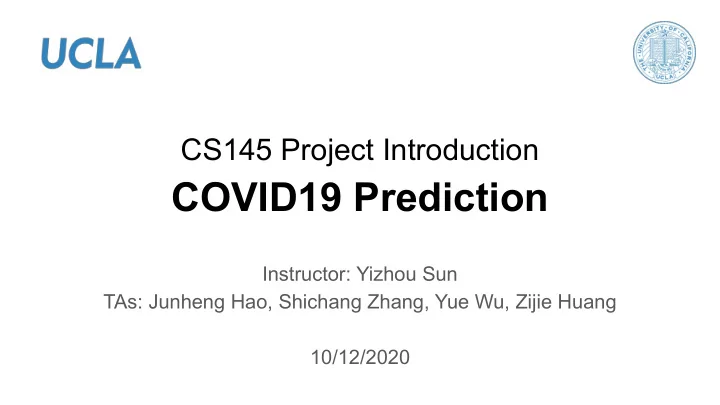

CS145 Project Introduction COVID19 Prediction Instructor: Yizhou Sun TAs: Junheng Hao, Shichang Zhang, Yue Wu, Zijie Huang 10/12/2020
Project Introduction ● Background & Motivation ● Project Task and Dataset ● Evaluation ● Project Deadlines and Grading
Background COVID19 Prediction : The rapid spread of COVID-19 has had and continues to have a significant impact on humanity. Accurately forecasting the progression of COVID-19 can help government monitor and take actions to combat it. [1]https://www.cdc.gov/coronavirus/2019-ncov/covid-data/forecasting-us.html
Background Motivation ● Based on various daily monitoring data of each U.S. state for a given time period (e.g. Apr-Aug), for an unseen time period (Sept), can you predict the daily #case and #death for each state? ● Timeseries Prediction with various types of data. ● A good fit for our class! [1]https://github.com/CSSEGISandData/COVID-19/tree/master/csse_covid_19_data
Task Based on the information from Apr.12 to Aug.31 of : ● Timeseries data for each state : ○ 10 features with full description on JHU_github ○ Features: 'Confirmed', 'Deaths', 'Recovered', 'Active', 'Incident_Rate', 'People_Tested', 'People_Hospitalized' ,'Mortality_Rate', 'Testing_Rate', 'Hospitalization_Rate' Daily mobility data among different states [1] ● ● (Optional) Datasources can be added by yourselve :D (e.g. Placekey community data product) ○ Additional data can be used after permission by TAs. (Overall, any data that is befor Sep.01.2020 should be fine. ) [1]https://docs.safegraph.com/docs
Task Aim: Predict #case, #death (cumulative value) for each state from Sep.1-26 : ● Output 1: Daily predicted # case, # death for each state ○ # of predication values: 26*50*2 ● Output 2: Daily predicted #case, # deaths on the final week data which would have ground truth only after you submitted your predictions. (can use data up to the prediction starting date to finetune your model.) ○ # of prediction values: 7*50*2 ● Ground Truths are accessible online for Output 1. DO NOT use them! (Test set leakage will be scored 0 for Output 1). ● We will test your model’s performance on Output 2, also possibly reproduce you reported results for Output1 and Output2.
Task How to evaluate: ● MAPE: mean absolute percentage error (take the average over all datapoints) ● Leaderboard ranking depends on Output1, but final projects score would depends on both Output 1 and Output 2. Try your model on the Kaggle competition (limited 3 submissions per day): https://www.kaggle.com/t/ff4c063c7b844ac29e5b709801766038 Submission file name: TeamNumber_Model.csv (e.g. Team1.csv) More details read the information on Kaggle website.
Project Grading (Total 25 Points) ● Midterm Report ( 2 points) ● Final Report ( 10 points) ○ Clairity in model explanation, different implemented model variants, etc. ● Performance on Kaggle ( 13 points) ○ Evaluated by the results both from Output 1 and Output 2 ○ Both MAPE score and rankings among all groups ○ Passing scores (~60%, 7 points) for models outperforming the given baselines; scores of most groups will range between 80%-100% (9-13 points).
Project Group Formation ● Submit group information and register your group on Kagge by the end of Week 2. ● Team name, Group ID (will be assigned), member info (names, UIDs, emails)
Project Midterm Report ● Approximately 3 pages ● Current progress about project, including ○ Data processing and transformation ○ Designed & tested models / methods ● Discussion and future project plan ○ Some conclusions and findings ○ Analysis of current models and techniques ○ Timeline of future project plan (around the next 4 weeks)
Project Final Report ● No longer than 10-page PDF in ACM paper format: https://www.acm.org/publications/proceedings-template ● Must include: ○ Group member information ○ Data selection and pre-processing ○ Model and techniques ○ Evaluation, observations and insights, conclusion ○ Current leaderboard rank and score ○ References and credit (papers, other’s codes, maximum 1 page) ○ Related work (maximum ½ page) ○ Task distribution form ○ Peer evaluation form (separately submitted by individuals) ● Must NOT include: ○ Background or too much description on given original datasets ○ Any source code
Task Distribution Form: Example Task People Data processing Student A Implementation: Algorithm 1 Student B, C Implementation: Algorithm 2 Student B, D Implementation: Algorithm 3 Student A, D Writing final report Student C
Peer Evaluation Form: Example NAMES CRITERIA John Alice Bob Attendance at group meetings 4 4 3 Availability when needed 5 4 3 Highly contributed to writing and proof reading of the final report. 5 5 1 Reliability 5 5 2 Contributed ideas that were of high quality. 4 5 2 Approximately, the amount of time spent on this project was comparable to other group members. 5 5 2 Overall (Would you work with them again?) 5 5 2 Question: Do you think some member in your group should be given a lower score than the group score? If yes, please list the name, and explain why.
Important Dates & Milestones ● Oct.18 : Group formation due ● Nov. 9 : Midterm project report due ● Dec.10 : Kaggle Submission Due (release new data for Output2 around a week before) ● Dec.18 : Final project report due (together with all codes) Note that the deadlines are subject to change according to the class schedule (avoid other deadlines of homework and exams).
Q & A
Thank you! Enjoy “mining” and good luck!
Recommend
More recommend